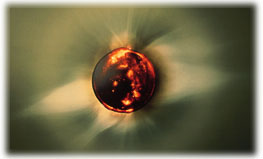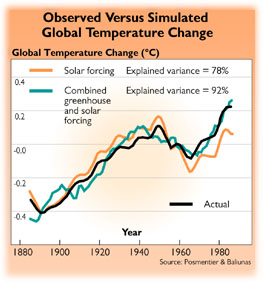Main Menu · Search ·Current Issue ·Contact ·Archives ·Centennial ·Letters to the Editor ·FAQs

 An x-ray photograph of the sun shows extremely hot gases heated by magnetic fields from sunspots. SERGE KOUTCHMY/LEON GOLUB/SAO/CFH-T
An x-ray photograph of the sun shows extremely hot gases heated by magnetic fields from sunspots. SERGE KOUTCHMY/LEON GOLUB/SAO/CFH-T |
DISK CHANGER
To the naked eye, the sun appears as smooth-complexioned as a baby. But those with telescopes know that the sun not only gives freckles, it has them: from five to a hundred sunspots dot the sun's face at all times. Recently, two astronomers have been exploring the link between these freckles and changes in the earth's climate.
Sallie Baliunas, Ph.D. '80, and Willie Soon, both associates of the Harvard-Smithsonian Center for Astrophysics, note that sunspots are prime indicators of a cycle in which the sun dims, then brightens, every 11 years. This periodic shift in radiance, say the astronomers, may explain much of the global warming usually attributed to the human production of greenhouse gases.
Sunspots, which are darker and cooler (by about 1,000 degrees Fahrenheit) than the surrounding areas (where temperatures reach 11,000 degrees), are places where strong magnetic fields make giant loops that circulate in and out of the gaseous solar surface. More sunspots indicate more magnetic activity--and a brighter sun, because the brighter areas (called faculae) that surround sunspots far outshine their dimness. The result is increased overall radiance when the sunspot count is high.
 Actual change in global temperature compared with hypothetical change based on a model of solar changes and a model that adds "greenhouse gases" data to the solar effect. These hypotheses can explain, statistically, much of the measured change in global temperature. STEPHEN ANDERSON
Actual change in global temperature compared with hypothetical change based on a model of solar changes and a model that adds "greenhouse gases" data to the solar effect. These hypotheses can explain, statistically, much of the measured change in global temperature. STEPHEN ANDERSON |
The sunspot count and radiance measurements are currently increasing, as they have for several years. The best predictions put the sun's next radiant peak in the year 2000. For the current sunspot cycle and the one preceding it, instruments have recorded a 0.14 percent increase in brightness, measured from trough-to-peak within each cycle.
Baliunas points out that this change in brightness, even if matched in every cycle of the last 100 years, could not account for the one-degree rise in global temperature since 1880. But she and Soon are investigating whether larger increases in solar brightness in some of the earlier cycles could explain the warming of the last 100 years, and also the two-degree rise in the global mercury since the beginning of the eighteenth century. Although no scientist has defined an exact relationship between magnetism, solar brightness, and temperatures on Earth, the Harvard team wondered if the brightening-sun scenario was plausible. This question turned them to astronomical history.
Galileo recorded the first sunspot data in the 1600s. Throughout that century, however, sunspot counts were quite low. Until the 1970s, astronomers explained this fact, somewhat unsatisfactorily, as a product of small telescopes. But, Baliunas says, "You don't need a large telescope to see sunspots."
The discovery of carbon-14 and beryllium-10 residue in tree rings partially solved the mystery. These isotopes ran in an 11-year pattern that seemed coincident with the sunspot cycle. Scientists hypothesized that when the sun's magnetic field is strong, it reinforces the earth's own magnetic field, providing our planet with protection from incoming cosmic rays that form isotopes. An analysis of tree-ring data for the seventeenth century showed a high concentration of isotopes, indicating a weak solar magnetic field over several cycles and confirming the accuracy of sunspot records from the time. Indeed, climate records reveal a "little ice age" between 1640 and 1720 during which temperatures dipped five degrees in northern Europe and one degree globally. The current surge in warming could be a natural correction for this era. Baliunas says there have been 19 "cold periods" in the last 10,000 years, and that a decreased solar magnetism has been linked to 17 of them.
The astronomers also looked outside the solar system, and found that our sun's periodic condition is far from unique. "The sun is just one star," Baliunas says. "We didn't want to wait around for it to change." Instead, the duo classified a series of "sun-like" stars--of similar mass and age to our own--and extracted comparative sunspot and brightness information. Their findings were compelling. All the stars they studied had sunspot cycles on the order of a decade. Stars on the younger end of the scale tended to have more erratic cycles, larger, more frequent sunspots, and--strangely--an inverse relationship between magnetism and brightness. Older stars behaved more like the sun--and had cycles in which brightness may increase, trough-to-peak, as much as 0.5 percent.
Back on Earth, sunspot records indicate a general rise in solar magnetism over the past 300 years. These records suggest that some of the sun's previous cycles were much stronger than the current one, perhaps with brightness increases as high as 0.5 percent. A few such cycles might explain the long-term warming trend in the earth's temperatures.
So why has the sun-climate connection been ignored for so long? Soon and Baliunas say that most atmospheric data are used in the service of meteorology, to monitor changing conditions on a daily basis. "The most obvious thing the sun provides is the change from day to night," Soon says. "Then the seasons, when you broaden the time scale." Fluctuations in solar brightness happen gradually, over a much longer period. So, until the advent of radiance-measuring satellites, many viewed the sun as a kind of atmospheric constant, so omnipresent as to approach invisibility. Yet, as Baliunas says, "The sun's fingerprint is everywhere."
~ Matt O'Keefe